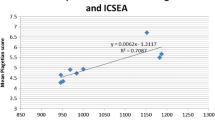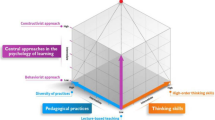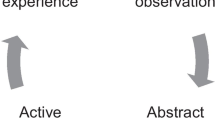Abstract
A major challenge for education and educational research is to build on our present understanding of learning for designing environments for education that are conducive to fostering in students self-regulatory and cooperative learning skills, transferable knowledge, and a disposition toward competent thinking and problem solving. Taking into account inquiry-based knowledge on learning and recent instructional research, this article presents the CLIA-model (Competence, Learning, Intervention, Assessment) as a framework for the design of learning environments aimed to be powerful in eliciting in students learning processes that facilitate the acquisition of productive knowledge and competent learning and thinking skills. Next, two intervention studies are described that embody major components of this framework, one focussing on mathematical problem solving in primary school, and a second one relating to self-regulatory skills in university freshmen. Both studies were carried out in parallel with the development of the framework, and were instrumental in identifying and specifying the different components of the model. They yielded both promising initial support for the model by showing that CLIA-based learning environments are indeed powerful in facilitating in students the acquisition of high-literacy learning results, especially the acquisition and transfer of self-regulation skills for learning and problem solving.
Résumé
Un défì important pour l’éducation et la recherche pédagogique est de développer en partant de notre compréhension actuelle de l’apprentissage des environnements éducationnels susceptibles de promouvoir chez les étudiants des habiletés d’apprentissage autorégulatrices et collaboratives, des connaissances transférables, et une disposition orientée vers le raisonnement et la résolution de problèmes compétents. Tenant compte des résultats de la recherche sur l’apprentissage et l’enseignement, cet article présente le modèle “CLIA (Competence, Learning, Intervention, Assessment)” comme cadre de référence pour concevoir des environnements d’apprentissage visés à stimuler chez les étudiants des processus d’apprentissage qui facilitent l’acquisition de connaissances productives et des habiletés compétentes d’apprentissage et de raisonnement. Ensuite, deux recherches d’intervention sont présentées qui représentent les composantes majeures du modèle CLIA: une expérience porte sur la résolution de problèmes mathématiques dans l’enseignement primaire, et la seconde a pour objet les habiletés autorégulatrices chez des étudiants en première année de l’université. Ces recherches ont été réalisées en parallèle avec le développement du modèle, et ont été instrumentales pour l’identification et la spécification des différentes composantes du modèle. Les deux investigations ont apporté du support initial pour le modéle en montrant que des environnements d’apprentissage basés sur le cadre de référence CLIA sont en effet stimulants pour faciliter chez les étudiants l’acquisition de résultats d’apprentissage d’ordre supérieur, spécialement l’acquisition et le transfert d’habiletés d’autorégulation de l’apprentissage et de la résolution de problèmes.
Similar content being viewed by others
References
Berry, J., & Sahlberg, P. (1996). Investigating pupils’ ideas of learning.Learning and Instruction, 6, 19–36.
Boekaerts, M. (1993). Being concerned with well-being and with learning.Educational Psychologist, 28, 149–167.
Brown, A.L. (1994). The advancement of learning.Educational Researcher, 28(8), 4–12.
Brown, A.L., & Campione, J.C. (1994). Guided discovery in a community of learners. In K. McGilly (Ed.),Classroom lessons: Integrating cognitive theory and classroom practice (pp. 229–270). Cambridge, MA: The MIT Press.
Brown, A.L., & Campione, J.C. (1996). Psychological theory and the design of innovative learning environments: On procedures, principles, and systems. In L. Schauble & R. Glaser (Eds.),Innovations in learning: New environments for education (pp. 289–325). Mahwah, NJ: Lawrence Erlbaum Associates.
Brown, R., Pressley, M., Van Meter, P., & Schuder, T. (1996). A quasi-experimental validation of transactional strategies instruction with low-achieving second-grade readers.Journal of Educational Psychology, 88, 18–37.
Bruer, J.T. (1993).Schools for thought: A science of learning in the classroom. Cambridge, MA: The MIT Press.
Burkhardt, H., & Schoenfeld, A. (2003). Improving educational research: Toward a more useful, more influential, and better-funded enterprise.Educational Researcher, 32(9), 3–14.
Campione, J.C., Shapiro, A.M., & Brown, A.L. (1995). Forms of transfer in a community of learners: Flexible learning and understanding. In A. McKeough, J. Lupart, & A. Marini (Eds.),Teaching for transfer: Fostering generalization in learning (pp. 35–68). Mahwah, NJ: Lawrence Erlbaum Associates.
Cobb, P., Confrey, J., diSessa, A., Lehrer, R., & Schauble, L. (2003). Design experiments in educational research.Educational Researcher, 32(1), 9–13.
Cognition and Technology Group at Vanderbilt (1990). Anchored instruction and its relationship to situated cognition.Educational Researcher, 19(6), 2–10.
Cognition and Technology Group at Vanderbilt. (1997).The Jasper Project: Lessons in curriculum instruction, assessment, and professional development. Mahwah, NJ: Lawrence Erlbaum Associates.
Cognition and Technology Group at Vanderbilt (2000). Adventures in anchored instruction: Lessons from beyond the ivory tower. In R. Glaser (Ed.),Advances in instructional psychology. Volume 5: Educational design and cognitive science (pp. 35–99). Mahwah, NJ: Lawrence Erlbaum Associates.
Cohen, J. (1988).Statistical power analysis for the behavioral sciences. Hillsdale, NJ: Lawrence Erlbaum Associates.
Collins, A., Brown, J.S., & Newman, S.E. (1989). Cognitive apprenticeship: Teaching the crafts of reading, writing, and mathematics. In L. Resnick (Ed.),Knowing, learning, and instruction: Essays in honor of Robert Glaser (pp. 453–494). Hillsdale, NJ: Lawrence Erlbaum Associates.
Corno, L., Cronbach, L.J., Kupermintz, H., Lohman, D.F., Mandinach, E., Porteus, A.W., et al. (2002).Remaking the concept of aptitude: Extending the legacy of Richard E. Snow. Mahwah, NJ: Lawrence Erlbaum Associates.
De Corte, E. (1996). Instructional psychology: Overview. In E. De Corte & F.E. Weinert (Eds.),International encyclopedia of developmental and instructional psychology (pp. 33–43). Oxford, UK: Elsevier Science Ltd.
De Corte, E. (2000). Marrying theory building and the improvement of school practice: A permanent challenge for instructional psychology,Learning and Instruction, 10, 249–256.
De Corte, E. (2003). Transfer as the productive use of acquired knowledge, skills, and motivations.Current Directions in Psychological Science, 12, 142–146.
De Corte, E. (2004). Mainstreams and perspectives in research on learning (mathematics) from instruction.Applied Psychology: An International Review, 53, 279–310.
De Corte, E., & Verschaffel, L. (1989). Teaching word problems in the primary school. What research has to say to the teacher. In B. Greer & G. Mulhern (Eds.),New developments in teaching mathematics (pp. 85–106). London: Routledge.
De Corte, E., Greer, B., & Verschaffel, L. (1996). Mathematics teaching and learning. In D.C. Berliner & R.C. Calfee (Eds.),Handbook of educational psychology (pp. 491–549). New York: Macmillan.
Design-Based Research Collective. (2003). Design-based research: An emerging paradigm for educational inquiry.Educational Researcher, 32(1), 5–8.
European Round Table of Industrialists (ERT) (1995).Education for Europeans. Towards a learning society. Brussels, Belgium: ERI.
Gage, N.L. (1996). Confronting counsels of despair for the behavioral sciences.Educational Researcher, 25(3), 5–15, 22.
Glaser, R. (1976). Components of a psychology of instruction: Toward a science of design.Review of Educational Research, 46, 1–24.
Glaser, R. & Silver, E. (1994). Assessment, testing, and instruction: Retrospect and prospect. In L. Darling-Hammond (Ed.),Review of research in education (Vol. 20, pp. 393–419). Washington, DC: American Educational Research Association.
Kelly, A.E. (2003). The role of design in educational research (Theme issue).Educational Researcher,32(1).
Levin, J.R., & O’Donnell, A.M. (1999). What to do about educational research’s credibility gap?Issues in Education: Contributions from Educational Psychology, 5, 177–229.
Masui, C. (2002).Leervaardigheid bevorderen in het hoger onderwijs: Een ontwerponderzoek bij eerstejaarsstudenten [Enhancing learning competence in higher education: A design experiment with university freshmen] (with a summary in English). Leuven: Universitaire Pers Leuven.
Masui, C, & De Corte, E. (1999). Enhancing learning and problem-solving skills: Orienting and self-judging, two powerful and trainable tools.Learning and Instruction, 9, 517–542.
Masui, C., & De Corte, E. (in press). Learning to reflect and to attribute constructively as basic components of self-regulated learning.British Journal of Educational Psyychology.
Masui, C., Borremans, A., Van Damme, J., & Vandenberghe, R. (1986). Technieken voor het expliciteren en interpreteren van oplossingsgedrag in het kader van studiebegeleiding [Techniques for the verbalization and interpretation problem-solving behavior within the framework of study guidance]. In E. De Corte (Ed.).Onderwijsleerprocessen: Bevindingen van Leuvens onderwijspsychologisch onderzoek [Teaching-learning processes: Findings of Leuven instructional psychology research]. Leuven/Amersfoort: Acco.
Mayer, R. E. (2001). Changing conceptions of learning: A century of progress in the scientific study of education. In L. Corno (Ed.),Education across a century: The centennial volume. Hundredth Yearbook of the National Society for the Study of Education (pp. 34–75). Chicago, IL: National Society for the Study of Education.
Ministerie van de Vlaamse Gemeenschap (1997).Gewoon basisonderwijs: Ontwikkelingsdoelen en eindtermen. Besluit van mei ’97 en decreet van juli ’97 [Educational standards for the elementary school] Brussel: Department Onderwijs, Centrum voor Informatie en Documentatie.
National Research Council (2000). How people learn: Brain, mind, experience, and school. In J.D. Bransford, A.L. Brown, & R.R. Cocking (Eds.),Committee on Developments in the Science of Learning with additional material from the Committee on Learning Research and Educational Practice. Washington, DC: National Academy Press.
Palincsar, A.S., & Brown, A.L. (1984). Reciprocal, teaching of comprehension-fostering and monitoring activities.Cognition and Instruction, 1, 117–175.
perkins, D.N. (1995).Outsmarting IQ: The emerging science of learnable intelligence. New York: The Free Press.
Resnick, L.B. (1983). Toward a cognitive theory of instruction. In S.G. Paris, G.M. Olson, & H.W. Stevenson (Eds.),Learning and motivation in the classroom (pp. 5–38). Hillsdale, NJ: Lawrence Erlbaum Associates.
Salomon, G., & Perkins, D.N. (1998). Individual and social aspects of learning. In P.D. Pearson & A. Iran-Nejad (Eds.).Review of research in education (Vol. 23, pp. 1–24). Washington, DC: American Educational Research Association.
Scardamalia, M., Bereiter, C., & Steinbach, R. (1984). Teachability of reflective processes in written composition.Cognitive Science, 8, 173–190.
Schoenfeld, A.H. (1985).Mathematical problem solving. New York: Academic Press.
Schunk, D.H., & Zimmerman, B.J. (Eds.). (1998).Self-regulated learning: From teaching to self-reflective practice. New York/London: The Guilford Press.
Shavelson, R.J., & Baxter, G.P. (1992). Linking assessment with instruction. In F.K. Oser, A. Dick, & J.L. Patry (Eds.),Effective and responsible teaching. The new synthesis (pp. 80–90). San Francisco, CA: Jossey-Bass Publishers.
Shepard, L.A. (2001). The role of classroom assessment in teaching and learning. In V. Richardson (Ed.).Handbook of research on teaching (4th ed., pp. 1066–1101). Washington, DC: American Educational Research Association.
Shuell, T.J. (1988). The role of the student in learning from instruction.Contemporary Educational Psychology, 13, 276–295.
Slavin, R.E. (2002). Evidence-based education policies: Transforming educational practice and research.Educational Researcher, 31(7), 15–21.
Snow, R.E. & Swanson, J. (1992). Instructional psychology: Aptitude, adaptation, and assessment.Annual Review of Psychology, 43, 583–626.
Snow, R.E., Corno, L., & Jackson, D. III (1996). Individual differences in affective and conative functions. In D.C. Berliner & R.C. Calfee (Eds.).Handbook of educational psychology (pp. 242–310). New York: Macmillan.
Vermunt, J.D.H.M. (1995). Process-oriented instruction in learning and thinking strategies.European Journal of Psychology of Education, 10, 325–350.
Verschaffel, L., De Corte, E., Lasure, S., Van Vaerenbergh, G., Bogaerts, H., & Ratinckx, E. (1999). Learning to solve mathematical application problems: A design experiment with fifth graders.Mathematical Thinking and Learning, 1, 195–229.
Author information
Authors and Affiliations
Rights and permissions
About this article
Cite this article
De Corte, E., Verschaffel, L. & Masui, C. The CLIA-model: A framework for designing powerful learning environments for thinking and problem solving. Eur J Psychol Educ 19, 365–384 (2004). https://doi.org/10.1007/BF03173216
Received:
Revised:
Issue Date:
DOI: https://doi.org/10.1007/BF03173216




